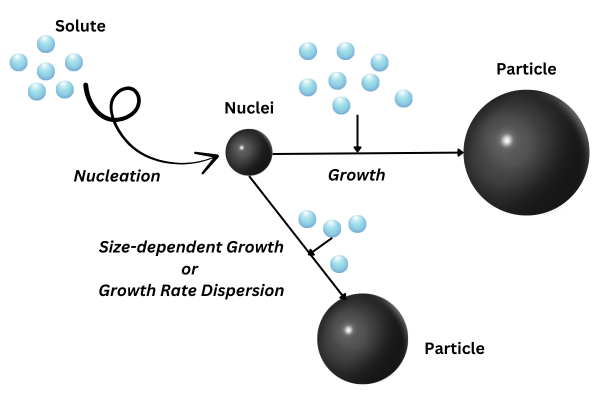Primary Particle Formation¶
In the following, we give a brief overview on the PBM equations for primary particle formation through growth, nucleation, growth rate dispersion. These equations can be combined with Aggregation Models and/or Fragmentation Models. For more information on the PBM implemented in CADET, please refer to [29] and [30].

Fig. 8 Nucleation, growth and growth rate dispersion in PBM. Note that dispersion is used to model (random) variance in growth speed, not the reduction of particle size.¶
Population Balance Model in a CSTR¶
We assume a well-mixed tank and choose the particle size \(x\in (x_c, \infty)\) as the internal coodinate, with \(x_c>0\) being the minimal particle size considered. The corresponding PBM is given as
where \(F_{in}, F_{out}\in \mathbb{R}^+\) are the volumetric inflow and outflow rates, \(V\in\mathbb{R}^+\) is the reactor volume, \(n(t, x)\colon [0, T_\text{end}] \times (x_c, \infty) \mapsto \mathbb{R}^+\) is the number density distribution, \(n_{in}\in\mathbb{R}^+\) is the number density distribution of the inlet feed, \(v_{G}\in\mathbb{R}^+\) is the particle growth rate, \(D_g\in\mathbb{R}^+\) is the growth dispersion rate.
The boundary conditions are given by the regularity boundary condition
and the nucleation kinetics boundary condition
where \(B_0\in\mathbb{R}^+\) is the nucleation kinetics factor representing particle nucleations of size \(x_c\in\mathbb{R}^+\).
The model is complemented by the following mass balance equation which accounts for the mass transfer between the particle phase and the solute phase
where \(c(t)\colon [0, T_\text{end}] \mapsto \mathbb{R}^+\) is the solute concentration in the bulk phase, \(c_{in}\in\mathbb{R}^+\) is the inlet solute mass concentration, \(\rho > 0\) is the nuclei mass density and \(k_v > 0\) is the volumetric shape factor of the particles.
Evolution of the reactor’s volume is governed by
Population Balance Model in a DPFR¶
The PBM can also be formulated for a DPFR to model continuous processes. That is, we choose the axial position within a DPFR as the external coordinate \(z\in[0, L]\) and formulate the \(2D\) PBM
where \(n(t, x, z)\colon [0, T_\text{end}] \times (x_c, \infty) \times [0, L] \mapsto \mathbb{R}^+\) is the number density distribution, \(v_\text{ax}\in\mathbb{R}^+\) is the axial velocity and \(D_{ax}\in\mathbb{R}^+\) is the axial dispersion coefficient.
Boundary conditions for the internal coordinate are again given by Eq. 28 and Eq. 29.
For the external coordinate \(z\), Danckwerts boundary conditions are applied:
The mass balance equation for the solute \(c(t, z)\colon [0,T-\text{end}] \times [0,L] \mapsto \mathbb{R}^+\) is given by
As for the particle phase, the solute mass concentration subjects to the Danckwerts boundary conditions
Constitutive equations¶
Constitutive equations describe the kinetic processes in the governing equations. The relative supersaturation \(s>0\) is:
where \(c_{eq}>0\) is the solute solubility in the solvent. The nucleation kinetics can be split into primary and secondary nucleation:
Which are in turn defined by the following constitutive equations. An empirical equation for primary nucleation is given by:
where \(k_p\in\mathbb{R}^+\) is the primary nucleation rate constant and \(u\in\mathbb{R}^+\) is a constant. An empirical power-law expression is used for the secondary nucleation:
where \(k_b\in\mathbb{R}^+\) is the secondary nucleation rate constant, \(b\in\mathbb{R}^+\) and \(k\in\mathbb{R}^+\) (usually set to \(1\)) are system-related parameters and \(M\in\mathbb{R}^+\) is the suspension density defined as
The following expression for the growth rate is implemented:
where \(k_g\in\mathbb{R}^+\) is the growth rate constant, \(\gamma\in\mathbb{R}^+\) quantifies the size dependence, and \(g, a, p\in\mathbb{R}^+\) are system-related constants.
For information on model parameters and how to specify the model interface, see Crystallization / Precipitation models.